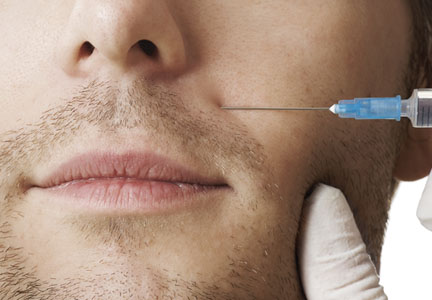User login

In the October 2013 issue of Dermatologic Surgery (2013;39:1434-1443), Keaney and Alster reviewed the use of botulinum toxin in men. Although botulinum toxin injection was the most common cosmetic procedure performed in 2011 in both sexes, men represented only 6% of participants. The authors reviewed the sexual differences in the anatomy of treatment areas. As described, men were noted to have more prominent supraorbital ridges, which contributed to a flatter eyebrow contour that was positioned lower along the orbital rim compared to women. Also the medial supraorbital ridge blended into the glabellar complex on men, giving a greater forward projection. Additionally, forehead height and width were greater in men and there was a greater backward slope compared to women. The female forehead had a greater contour and the female orbit was proportionally larger in relation to skull size. With regard to facial musculature, men were thought to have greater skeletal muscle mass. Men were reported to have greater upward vertical movement for facial expressions, which was thought to contribute to the differences in rhytide severity and distribution.
The authors also reviewed 2 published studies that accounted for sex in study design or subgroup analysis. In a study performed by Brandt et al (Dermatol Surg. 2009;35:1893-1901) of abobotulinumtoxinA for the treatment of glabellar lines, 158 participants (23 men [15%]) were randomized (2:1 ratio) to receive a single 50-U injection of abobotulinumtoxinA or placebo. This study found that women in the abobotulinumtoxinA group were more likely to respond than men, and therefore Brandt et al concluded that treatment of the male glabella required an abobotulinumtoxinA dose of more than 50 U.
What’s the issue?
The number of men seeking botulinum toxin injections has been increasing and therefore it is important to understand the inherent anatomic differences. There have been numerous clinical articles and trials using botulinum toxin but not all include men. It is important to consider the differences in muscle mass and anatomic differences when injecting botulinum toxin in men. Although clinical trials and studies provide guidelines on dosing, it is important to assess each patient individually according to muscle strength and mass. The standardized doses used in clinical trials may not be appropriate for all patients, especially men, because this patient population is not equally represented in these trials. Some male patients may state that botulinum toxin did not work, which may be due to inherent underdosing for the muscle size or strength. It is important to understand and appreciate these anatomic and structural differences in men when utilizing botulinum toxin. With a growing proportion of men seeking cosmetic treatments, are you equipped to assess the nuances?

In the October 2013 issue of Dermatologic Surgery (2013;39:1434-1443), Keaney and Alster reviewed the use of botulinum toxin in men. Although botulinum toxin injection was the most common cosmetic procedure performed in 2011 in both sexes, men represented only 6% of participants. The authors reviewed the sexual differences in the anatomy of treatment areas. As described, men were noted to have more prominent supraorbital ridges, which contributed to a flatter eyebrow contour that was positioned lower along the orbital rim compared to women. Also the medial supraorbital ridge blended into the glabellar complex on men, giving a greater forward projection. Additionally, forehead height and width were greater in men and there was a greater backward slope compared to women. The female forehead had a greater contour and the female orbit was proportionally larger in relation to skull size. With regard to facial musculature, men were thought to have greater skeletal muscle mass. Men were reported to have greater upward vertical movement for facial expressions, which was thought to contribute to the differences in rhytide severity and distribution.
The authors also reviewed 2 published studies that accounted for sex in study design or subgroup analysis. In a study performed by Brandt et al (Dermatol Surg. 2009;35:1893-1901) of abobotulinumtoxinA for the treatment of glabellar lines, 158 participants (23 men [15%]) were randomized (2:1 ratio) to receive a single 50-U injection of abobotulinumtoxinA or placebo. This study found that women in the abobotulinumtoxinA group were more likely to respond than men, and therefore Brandt et al concluded that treatment of the male glabella required an abobotulinumtoxinA dose of more than 50 U.
What’s the issue?
The number of men seeking botulinum toxin injections has been increasing and therefore it is important to understand the inherent anatomic differences. There have been numerous clinical articles and trials using botulinum toxin but not all include men. It is important to consider the differences in muscle mass and anatomic differences when injecting botulinum toxin in men. Although clinical trials and studies provide guidelines on dosing, it is important to assess each patient individually according to muscle strength and mass. The standardized doses used in clinical trials may not be appropriate for all patients, especially men, because this patient population is not equally represented in these trials. Some male patients may state that botulinum toxin did not work, which may be due to inherent underdosing for the muscle size or strength. It is important to understand and appreciate these anatomic and structural differences in men when utilizing botulinum toxin. With a growing proportion of men seeking cosmetic treatments, are you equipped to assess the nuances?

In the October 2013 issue of Dermatologic Surgery (2013;39:1434-1443), Keaney and Alster reviewed the use of botulinum toxin in men. Although botulinum toxin injection was the most common cosmetic procedure performed in 2011 in both sexes, men represented only 6% of participants. The authors reviewed the sexual differences in the anatomy of treatment areas. As described, men were noted to have more prominent supraorbital ridges, which contributed to a flatter eyebrow contour that was positioned lower along the orbital rim compared to women. Also the medial supraorbital ridge blended into the glabellar complex on men, giving a greater forward projection. Additionally, forehead height and width were greater in men and there was a greater backward slope compared to women. The female forehead had a greater contour and the female orbit was proportionally larger in relation to skull size. With regard to facial musculature, men were thought to have greater skeletal muscle mass. Men were reported to have greater upward vertical movement for facial expressions, which was thought to contribute to the differences in rhytide severity and distribution.
The authors also reviewed 2 published studies that accounted for sex in study design or subgroup analysis. In a study performed by Brandt et al (Dermatol Surg. 2009;35:1893-1901) of abobotulinumtoxinA for the treatment of glabellar lines, 158 participants (23 men [15%]) were randomized (2:1 ratio) to receive a single 50-U injection of abobotulinumtoxinA or placebo. This study found that women in the abobotulinumtoxinA group were more likely to respond than men, and therefore Brandt et al concluded that treatment of the male glabella required an abobotulinumtoxinA dose of more than 50 U.
What’s the issue?
The number of men seeking botulinum toxin injections has been increasing and therefore it is important to understand the inherent anatomic differences. There have been numerous clinical articles and trials using botulinum toxin but not all include men. It is important to consider the differences in muscle mass and anatomic differences when injecting botulinum toxin in men. Although clinical trials and studies provide guidelines on dosing, it is important to assess each patient individually according to muscle strength and mass. The standardized doses used in clinical trials may not be appropriate for all patients, especially men, because this patient population is not equally represented in these trials. Some male patients may state that botulinum toxin did not work, which may be due to inherent underdosing for the muscle size or strength. It is important to understand and appreciate these anatomic and structural differences in men when utilizing botulinum toxin. With a growing proportion of men seeking cosmetic treatments, are you equipped to assess the nuances?
